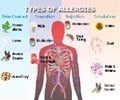Most students with food allergies either don't understand the seriousness of their problem or are often in environments where they could not be treated during emergency, researchers have found.
Most students with food allergies either don't understand the seriousness of their problem or are often in environments where they could not be treated during emergency, researchers have found.
Even grade-school students are often in school environments where there is no food allergy policy, and where instructors are not trained how to treat an emergency food allergy reaction."Food-allergic individuals need to increase the awareness of their food allergy among the people around them," said lead researcher Matt Greenhawt, M.D. from Allergy and Asthma Centre, LLC in the Atlanta metro area.
"This would include not only telling them that they are food allergic but also showing them how to treat them and how to recognize signs of an ongoing reaction," he added.
The most common food allergies include peanuts, tree nuts, milk, eggs, fish, shellfish, soy and wheat.
During the study, the research team from the University of Michigan Health System found that only 50 percent of the students who identified themselves as having an allergy to a food said they always avoided the food.
Nearly two-thirds could said somebody close to them on campus was aware that they were food-allergic, while 60 percent said that either a roommate, house mate or suite mate was aware of his or her food allergy.
Advertisement
And only about 20 percent had self-injectable epinephrine - the recommended treatment - available to treat a reaction.
Advertisement
They also found that about 43 percent of food-allergic children have had at least one reaction at school, and nearly two-thirds of these occurred in children in kindergarten or younger.
McMorris said that the finding suggests that that these individuals might be at more risk than older children.
On college campuses, the use of self-injectable epinephrine to treat a reaction was irregular. While nearly three-quarters of the food-allergic children had epinephrine available, less than one-third received the treatment.
"Until all students who display symptoms of a severe reaction are receiving epinephrine, I would say that there's a significant gap that needs to be closed," said Greenhawt.
Source-ANI
SRM














